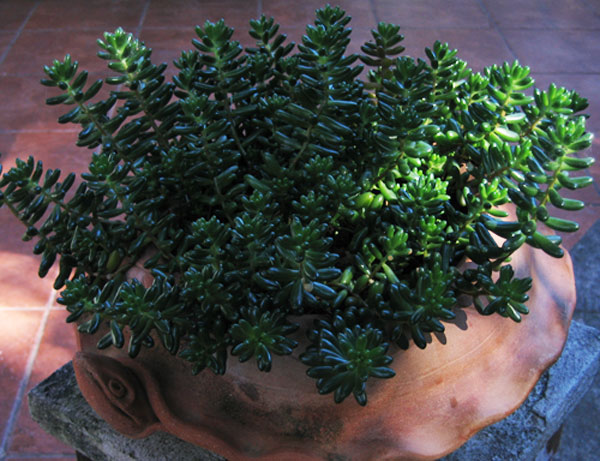| GreenGardeningCookingCuring.com | J
PAGE |
Tweet |
| HOME |
| Tour Our Destination Websites | Taxco-Today.com | Oaxaca-Today.com | Montserrat-Today Site |
| See our silver designs at Krika.com | Read our travel stories and other tales at Krika.com |
|
|
| Jacaranda
Tree Jacaranda
mimosafolia D. Don or Jacaranda acutifolia HUMB.
and BONPL. or Jacaranda cuspidifolia Just after dropping its feathery leaves, the jacaranda bursts into purple blooms. It is maybe best identified by the seed pods which are almost always hanging from the tree, but don't mistake it for a flamboyant which has similar seed pods. It reaches its full height of forty to sixty feet when mature when it will also have a fifty foot spread. It is a common tree in Taxco and in almost all parts of Mexico. Benefits: In Panama the bark is used in treating skin diseases. From: The jacaranda originated in Brazil according to one botanist or in northwestern Argentina according to another. Still others believe its origin to have been in Mexico, Central and South America and the Caribbean. The Jacaranda is also very common in South Africa, so who knows? Photograph: These photographs were taken in Colonia Reforma, a suburb of Oaxaca, Mexico. Planting and Care: It does best in full sun and it will tolerate a long dry season, eight months in most of Mexico. Jacarandas do not do particularly well in very windy locations. Text and Photographs ©KO 2008/2010 and ©GreenGardeningCookingCuring.com 2012/2018 |
||
|
||
 **Jade
Plant, Jade Tree, Gollum Jade, Succulent Spoon Jade Shrek
Plant, Trumpet Jade, Money Plant Crassula
ovata, Crassula ovata, Crassula argentea **Jade
Plant, Jade Tree, Gollum Jade, Succulent Spoon Jade Shrek
Plant, Trumpet Jade, Money Plant Crassula
ovata, Crassula ovata, Crassula argenteaThis is a very appealing plant with thick deep green fleshy leaves on stems that make the overall plant look like a tiny ancient tree. They are very easy to grow either as house plants or outside where there is no frost. They will get quite large when they are happy. Benefits: From: South Africa Planting and Growth: Jade plants like good light and can handle the Caribbean sun, but preferably only in the early morning. If you plant them in your garden, do so in an area that receives some sun and regular rainfall or you'll have to do light watering. Text and Photographs Copyrighted ©GreenGardeningCookingCuring.com 2014 |
||
|
||
 Jamaican
Forget-Me-Not, Bushviolet, Amethyst Flower Browallia
americana Jamaican
Forget-Me-Not, Bushviolet, Amethyst Flower Browallia
americanaThis is a warm climate perennial that comes with white, blue or purple blossoms. Benefits: From: Tropical Americas Photographed: In the Botanical Garden at the Hotel Atitlan on Lake Atitlan in Guatemala. Planting and Care: This plant does best in semi shade planted in a rich soil and given plenty of rainfall or watering. Don't hesitate to pinch it back to maintain and attractive shape. Text and Photograph ©GreenGardeningCookingCuring.com 2013/2018 This Flower Mystery was solved by Ursula G. living in Southern Germany |
||
  Jamaican
Plum Tree, Chile Plum, Governor's Plum, Hog Plum, Purple
Mombin, Purple Plum, Red Mombin, Red Plum, Scarlet Plum,
Spanish Plum, Wild Plum, Coolie Plum Jamaican
Plum Tree, Chile Plum, Governor's Plum, Hog Plum, Purple
Mombin, Purple Plum, Red Mombin, Red Plum, Scarlet Plum,
Spanish Plum, Wild Plum, Coolie PlumThis looks like a fast growing 'weed' tree that will reach to about 25 feet in height when mature. I found it in the garden of a Tobagoin friend who had told us he 'trimmed' hair on the weekends in his little shop. I imagined he might be responsible for some of the wonderful hair styles I had seen in the supermarket where he worked as one of the managers during the week. As it turned out, he is a barber with all of the attendant tools and furniture. Bravely, I sat in his barber's chair and he set to work. He did a great job though I was his very first female customer. Afterwards we walked in his garden where he pointed out the fruiting trees, medicinal herbs, and vegetable plants he was growing. All in all it was one of my favorite afternoons in Tobago and we left happily with a bag of delicious plums. Benefits: This tree produces yummy fruits toward the beginning of summer in the Caribbean. From: Photographed: In Bon Accord, Tobago, in 2018. Planting and Care: Text and Photographs ©GreenGardeningCookingCuring.com 2018 |
||
| **Jamaica Sago See the PALMS AND SAGOS Page -- Jamaica Sago | ||
Japanese
Anemone, Japanese Wind Flower, Chinese Anemone, Thimbleweed,
Windflower Syn. Anemone
hupehensis, Anemone hupehensis var. japonica, Anemone × hybrida Flower Mysteries 2, 38. 48 and 57 were solved by Ursula G. living in Southern Germany Flower Mysteries 4 and 4a were identified by Susan I. a Twitter friend from Sydney, Australia |
||
|
||
Photographed: In
the Wellington Botanic Garden in Wellington, New Zealand,
in 2013. |
||
Photographed: At
the Roger Williams Park Botanical Center, Providence,
RI, in 2013 |
||
|
||
Photographed: In
the Blithewold Garden in Bristol, Rhode Island 2013.  |
||
Photographed: At
the Roger Williams Park Botanical Center, Providence,
RI, in 2013.
 |
||
| Japanese Rose, Eijitsu Rose (in Japanese) Rosa rugosa | ||
 Japanese
Umbrella Pine, Umbrella Pine, Koya-Maki (in Japanese) Sciadopitys
verticillata Japanese
Umbrella Pine, Umbrella Pine, Koya-Maki (in Japanese) Sciadopitys
verticillataThis is a slow growing delightful evergreen that would make a beautiful garden centerpiece. In many years it will reach a height of more than 60 feet. Benefits: I didn't find anything special except that this tree has become one of my favorites. We visit Rhode Island once a year usually and I always make sure to see "my tree." From: Japan Photographed: At the Roger Williams Park Botanical Center in Rhode Island in 2013. Planting and Care: This lovely pine will grow best in full sun or partial sun and bright shade in a garden spot with protection from strong winds. It is not fussy about the soil where it lives, but it must be moist and well drained and it must be acidic. Text and Photograph ©GreenGardeningCookingCuring.com 2014/2018 |
||
Jasmine is long known for its healing qualities though
none of the varieties here are said to convey those benefits. |
||
 Angel
Wing Jasmine Jasminum nitidum Angel
Wing Jasmine Jasminum nitidumAngel wing jasmine is a vine like shrub with white pinwheel shaped flowers that are tinged purple on the underside. As well, flowers on this jasmine are a little larger than on other jasmine plants. Its fragrant flowers bloom at night beginning in late spring and carry on through the summer months. When it is mature it will be about 10 feet tall and 3 or 4 feet wide. Benefits: Though other jasmine varieties are noted for their health benefits, I didn't find any medicinal uses for the angel wing. From: Papua New Guinea's Admiralty Islands Photographed: In the Botanical Garden at the Hotel Atitlan on Lake Atitlan in Guatemala. Planting and Care: Plant this in full sun and assure it routine rainfall or watering to keep it happy. It is not at all fussy about the soil in which it will live. Text & Photograph ©KO 2010 and ©GreenGardeningCookingCuring.com 2018 |
||
 Azores
Jasmine, Lemon-Scented Jasmine Jasminum
azoricum Azores
Jasmine, Lemon-Scented Jasmine Jasminum
azoricumLike many jasmine plants this climbing one is less appealing for its flowers and foliage than for its heavenly scent. Benefits: I found nothing specific to the Azores Jasmine. From: The Portuguese Island of Madeira in the Azores as the name suggests. Photographed: In the Botanical Garden at the Hotel Atitlan on Lake Atitlan in Guatemala. Planting and Care: Like most jasmines, this one is sensitive to cool and especially cold weather. It prefers to be planted in an always warm sunny area of the garden out of the wind where it will receive regular watering or rainfall. It will live comfortably in almost any soil type and isn't particular about the pH either. Text & Photograph ©GreenGardeningCookingCuring.com 2013/2018 |
||
|
||
|
||
Orange
Jasmine, Orange Jessamine, Mock Orange, Chinese Box Murraya
exotica My #14 Shrub Mystery was solved by two visitors to my website, Glenn who lives in Brisbane, Australia and Kim H. Many thanks for your help. |
||
|
||
 **Pinwheel
Jasmine Tabernacle
montana **Pinwheel
Jasmine Tabernacle
montanaThis is a delightful delicately flowering bush that pruned carefully has an airy lightness about it that is not characteristic of most tropical foliage. Its 3/4 inch flowers might be overlooked without their wonderful abundance. Our plants bloomed continuously for months. Pinwheel Jasmine can and often is used as a trimmed hedge which seems to rob it of all of its best qualities. Benefits: From: India Photographed: As a center piece in our herb garden at our former home in Montserrat. Planting and Care: Unlike most jasmines, this one prefers to have some shade from the hot mid-day sun. It will even grow well in bright shade free of direct sun. At maturity it will reach a height and width of about 5 feet. It likes to have routine rainfall or watering, but requires good drainage of the rich soil in which it does best. Text & Photographs ©KO 2008/2010 and ©GreenGardeningCookingCuring.com 2018 |
||
|
||
This shrub mystery was solved by Glenn a visitor to my website who lives in Brisbane, Australia. Many thanks for your help Glenn. |
||
  |
||
|
||
|
||
 |
||
| Buddha
Belly Plant, Bottleplant Shrub, Gout Plant, Purging-Nut,
Guatemalan Rhubarb, Goutystalk Nettlespurge Jatropha
padagrica Benefits: This plant was once used to produce dyes and now serves only as a powerful butterfly attractant. From: Tropical Latin America Photographed: As noted below. Planting and Care: Make sure to find a home for this plant in sunny place in the garden where there is well drained soil. Water it sparingly and it should do just fine. It will reach a height of only 3 feet so it may also be perfect for growing in a large unglazed clay pot. It is not frost hardy, so keep that in mind. Warning: Jatrophas are highly toxic. Text and Photographs ©GreenGardeningCookingCuring.com 2015/2018 |
||
|
||
|
||
 |
||
|
||
Photographed: In
our garden at Lake Atitlan in Guatemala |
||
 Jerusalem
Sage Lamiaceae phlomis tuberosa Jerusalem
Sage Lamiaceae phlomis tuberosaThis is a perennial plant that will grow a few feet in height. Not normally prized as a garden flower, it is often found growing wild on roadsides and in unused fields. It will flower most of the summer in New England and I found it very appealing. Benefits: Some parts of the plant are considered edible. From: The cold central parts of Europe eastward through to Siberia. Photographed: In the Botanical Garden in Palermo, Sicily, Italy, 2012. Planting and Care: Plant seeds in the place where you would like to see this grow. Full sun and routine watering or rainfall will keep the plants happy. Text and Photograph ©GreenGardeningCookingCuring.com 2013/2018 My #8 Flower Mystery was solved by Ursula G. living in Southern Germany |
||
Jewels
of Opar, Fame Flower, Flame Flower, Pink Baby's-Breath Talinum paniculatum My #50 Flower Mystery was solved by Ursula G. living in Southern Germany |
||
 |
||
| **Jimson Weed See The "D" Page DEVIL'S TRUMPET | ||
| Jitsuko's
Star Leopard Plant, Leopard Plant, Green Leopard Plant Farfugium
japonicum 'Jitsuko's Star' syn. Ligularia
tussilaginea This is a peculiarly appealing perennial plant with both very attractive foliage and spikes of pretty yellow daisy like flowers produced toward the end of the summer season. Benefits: I didn't find anything of interest. From: Japan Planting and Care: Jitsuko's star leopard is not frost hardy. It will grow happily in bright shade or in early morning or late afternoon sun in a place with rich humusy soil. It likes routine rainfall or watering, but in general is considered to be an easy plant to grow and maintain. Text & Photographs ©KO 2010 and ©GreenGardeningCookingCuring.com 2018 |
||
|
||
 Copper
Leaf, Joseph's Coat Acalypha wilkesiana Copper
Leaf, Joseph's Coat Acalypha wilkesianaCopper Leaf is a tropical and subtropical garden shrub growing to almost 10 feet tall and about 6 feet wide. It is an evergreen large enough to make a good privacy hedge. Benefits: It is used to treat skin disorders and is said to have other medicinal benefits as well. From: Pacific Islands. Photographed: In a neighbor's garden in Montserrat. Planting and Care: Copper leaf can handle full sun or bright shade though it does not appreciate strong winds. It likes to be planted in moist well-drained fertile organic soil. Text and Photograph ©KO 2010 and ©GreenGardeningCookingCuring.com 2018 |
||
 Fire
Dragon, Joseph's Coat, Match-Me-If-You-Can, Copper Leaf,
Beefsteak Plant, Jacobs
Coat, Three-seeded Mercury Acalypha
godseffiana Fire
Dragon, Joseph's Coat, Match-Me-If-You-Can, Copper Leaf,
Beefsteak Plant, Jacobs
Coat, Three-seeded Mercury Acalypha
godseffianaThis bush provides a striking bit of colorful and oddly shaped foliage in a tropical garden. From: This plant hales from humid and warm Fiji. Photographed: On the left at the Hotel Atitlan on Lake Atitlan in Guatemala. Planting and Care: This is an easy one as it grows in full sun with little water and the more sun it gets the more color it will have. It prefers well-drained soil. It is easily propagated by cuttings and will grow to be as tall as ten feet if happy. Keeping it well pruned will prevent it from becoming leggy. Text and Photograph ©KO 2010 and ©GreenGardeningCookingCuring.com 2018 |
||
Photographed
in Crown Point Tobago in 2017  |
||
 Joseph's
Coat Acalypha wilkesiana Hoffmanna Joseph's
Coat Acalypha wilkesiana HoffmannaThis is a leafy tall growing slender bush reaching a height of almost 10 feet. It does not appear to flower, but does serve as a decorative green and white background or filler plant. Benefits: I didn't find anything specific to this plant. From: Tropical and sub-tropical Americas. Photographed: At a neighbor's home in Montserrat. Planting and Care: This plant like the others in this group like well-drained moist soil and this one isn't at all fussy about what type of soil. It will do well in full sun or in a place in the garden that gets morning shade and afternoon sun. It does flower, but you have to look closely to find them. Text & Photograph ©Krika.com 2008/2010 and ©GreenGardeningCookingCuring.com 2018 |
||
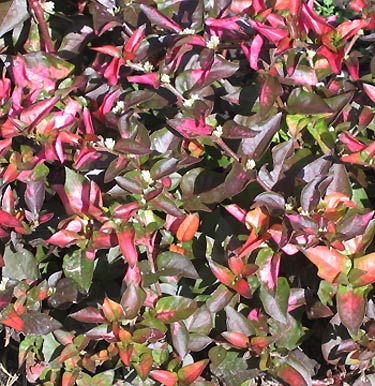 Joy
Weed, Joseph's Coat Alternanthera ficoidea Joy
Weed, Joseph's Coat Alternanthera ficoideaThis low growing plant is useful as a fill in as it brings a stable bit of color to a garden that may sometimes be lacking in blooms. It will grow to be only about 1 foot in height so it makes a good undergrowth planting. Benefits: I didn't find anything at all on this aspect of the plant. From: Mexico and South America Photographed: At the Hotel Atitlan on Lake Atitlan in Guatemala in 2010. Planting and Care: This Joseph's Coat is a warm climate perennial that will grow well in full sun or partial shade. It is easy to grow and likes routine watering or rainfall. Text and Photograph ©GreenGardeningCookingCuring.com 2014/2018 My #7 Plant Mystery was solved by Glenn a visitor to my website who lives in Brisbane, Australia. Many Thanks. |
||
 **Match-Me-If-You-Can,
Joseph's Coat, Acalypha
wilkesiana **Match-Me-If-You-Can,
Joseph's Coat, Acalypha
wilkesianaThis is a wonderful bit of greenery with each leaf seemingly a work of art combining greens and whites in never quite the same pattern, hence its common name. From: This plant hales from the humid and warm parts of the South Pacific. Photographed: In our deck garden at our former home in Montserrat. Planting and Care: Joseph's coat loves heat, moisture and sun and will delight you when it receives them. When it gets dry it looks very sad indeed. It is easy to grow from a cutting; put several in a sandy soil mix kept moist and in bright light and soon you'll have healthy new plants. Once in the garden, keep the dead flowers picked off and stem ends routinely pinched to have it at its best. Text and Photograph ©KO 2010 and ©GreenGardeningCookingCuring.com 2018 |
||
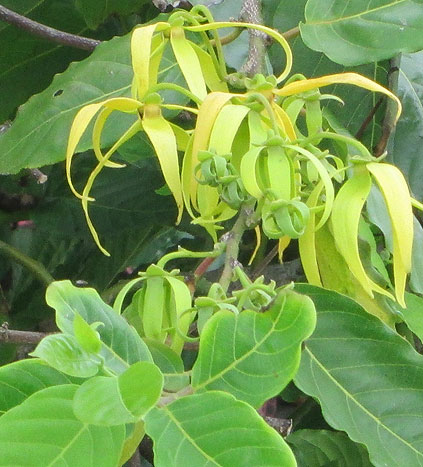 Joy
Perfume Tree, Champak, Yellow Jade Orchid Tree, Fragrant
Himalayan Champaca Magnolia champaca Joy
Perfume Tree, Champak, Yellow Jade Orchid Tree, Fragrant
Himalayan Champaca Magnolia champacaAlmost unbelievably, this sweet smelling flowering tree will grow to be over 150 feet tall. Benefits: Joy, the most expensive perfume in the world uses the flowers of this tree for their strong and appealing scent. Its scent is also a strong attractant for bees, birds and butterflies. Parts of the tree are used in traditional medicine and it is a source of wood and yellow dye. From: Tropical Asia Photographed: At the Magdalena Hotel in Tobago in 2018. Planting and Care: You will most likely purchase this tree and the sellers will give you the best information on planting it in your area. At the most basic it grows best in full sun with regular rainfall or watering. Text and Photograph ©GreenGardeningCookingCuring.com 2018 |
||
| **Jumbie
Beads, Crab's eye, Cock's
Eyes, Rosary Pea (and many, many more) Abrus
precatorius L. This is a tenacious twining vine that produces bright orange/red seeds used in jewelry and other crafts in the Caribbean. Benefits: Its seeds are poisonous, though other parts of the plant are used locally in Montserrat for their healing qualities. Planting and Care: Unless you plant to use the seeds, I would not recommend letting this plant grow in your garden. It is hard to eradicate and it is prolific. Text ©KO 2008 and ©GreenGardeningCookingCuring.com 2018 |
||
| **Jumbie Crab See The "W" Page -- WILDLIFE -- Black Crab | ||
I am very grateful to a Twitter follower, www.botanistadventures.com and botanistdesign.com for solving this plant mystery. |
||
|





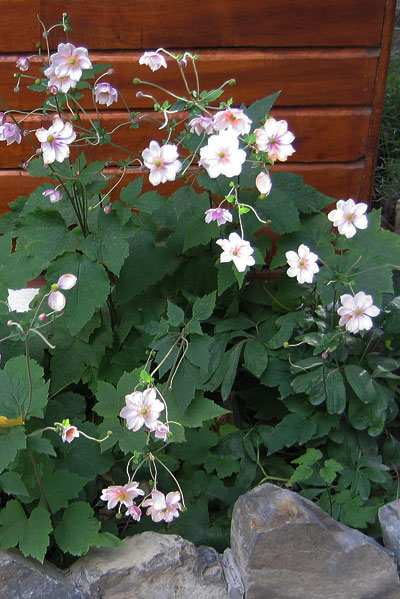

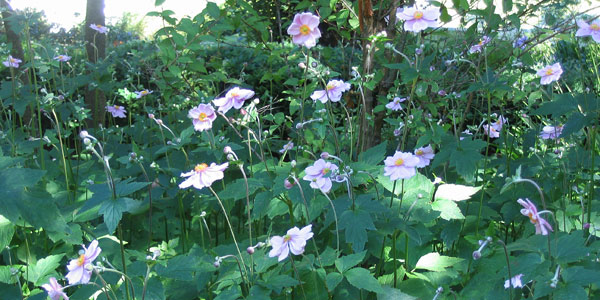



 Night
Blooming Jasmine Cestrum nocturnam
Night
Blooming Jasmine Cestrum nocturnam



 Star
Jasmine, Southern Jasmine, Trader's Compass, Confederate
Jasmine, Chinese Ivy, Chinese Jasmine Trachelospermum
jasminoides
Star
Jasmine, Southern Jasmine, Trader's Compass, Confederate
Jasmine, Chinese Ivy, Chinese Jasmine Trachelospermum
jasminoides **Spicy
Jatropha, Pergrina Jatropha
pandurata and Jatropha integerrima
**Spicy
Jatropha, Pergrina Jatropha
pandurata and Jatropha integerrima



 **Coral
Plant, Physic Nut Jatropha
multifida
**Coral
Plant, Physic Nut Jatropha
multifida 
